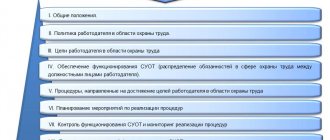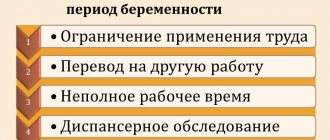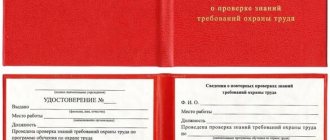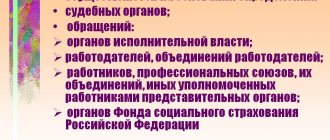Labor protection refers to a number of measures aimed at providing workers with optimal conditions for performing their job functions that would not pose a risk to the health and life of enterprise workers. This task is of particular importance and therefore falls within the competence of the government. We propose to understand what occupational safety management is, why state occupational safety management was needed, and how the powers and functions of the authorities are distributed.
What is the state management of labor protection
State management of labor protection is the activity of state authorities aimed at performing supervisory and control functions in the field of labor protection in accordance with state policy
. To guarantee safe working conditions for Russians, the list of state functions included tasks for:
- approval of preventive measures and elimination of violations of government regulations regarding labor protection;
- development of special programs to increase safety in the workplace;
- formation of adequate requirements for the organization of technological activities, production, use of fixed assets, etc.;
- maintaining up-to-date regulations, the norms of which are aimed at ensuring harmless conditions in the workplace.
Why should a country manage labor protection processes?
The desire to implement a labor protection system within the framework of state activities, or, in other words, the purpose of labor legislation is to ensure respect for the rights of working citizens to the opportunity to perform labor functions in safety, as well as to protect the interests of employers and personnel. It is implemented in the following tasks:
- ensuring the primary importance of saving the lives and preserving the health of working citizens;
- development, adoption and entry into force of regulations and targeted programs aimed at improving conditions and optimizing labor protection;
- checking compliance with adopted rules, laws and regulations on labor protection;
- expert assessment of the production environment;
- adopting work environment assessment procedures;
- promoting the prevention of emergencies and accidents at work;
- assistance to employees and members of their families whose health has suffered in the process of professional employment;
- clarification of circumstances and keeping records of facts of damage to health at work;
- financial support for labor protection measures;
- training and certification of labor safety inspectors;
- work with statistics on industrial accidents, occupational diseases and compensation paid for them;
- systematization of information related to optimization of the production environment and its protection;
- introduction of effective tax practices designed to ensure maximum efforts by employers to create and maintain a safe working environment;
- establishing standards regarding the provision of workers with protective and preventive means, medical care, appropriate sanitary and living conditions, etc.;
- mastering positive international experience in the labor protection field.
Why is state management of labor protection necessary?
The purpose of adopting legislative acts related to ensuring labor protection of enterprise employees is to respect the rights of employed persons to perform labor duties and protect the interests of employers and subordinates. State management of occupational safety and health is implemented by government agencies performing the following tasks:
- borrowing the positive experience of foreign enterprises in the field of labor protection;
- ensuring the primary importance of preserving the health of workers and saving their lives;
- approval of the procedure for providing company employees with acceptable sanitary and living conditions, issuing protective and preventive equipment to workers, and providing them with medical care;
- development, approval and publication of regulations and targeted programs, the purpose of which is to improve working conditions and optimize labor protection activities;
- development of a taxation procedure that encourages employers to provide employees with the most safe and comfortable working conditions;
- carrying out inspections of compliance with laws, rules and regulations relating to labor protection;
- systematization of information related to improving the working environment and labor protection;
- conducting an expert assessment of workplaces;
- analysis of statistical data on industrial accidents, occupational diseases, compensation amounts paid;
- organization of workplace assessment events;
- training and certification of labor safety inspectors;
- ensuring measures to prevent industrial accidents and emergencies;
- providing financial support for occupational safety and health measures;
- payment of compensation and provision of support to employees and members of their families if the employee’s health has suffered due to the performance of work duties;
- conducting investigations and recording of industrial accidents.
Key events
- Instructing all employees of the enterprise on a regular basis (at least once every 6 months); ;
- Conducting pre-trip (pre-shift), preliminary and periodic medical examinations;
- Development of the safest routes for movement around production workshops and premises;
- Installation and design of safety signs in accordance with GOST 12.4.026 - 2015;
- Providing employees with means of individual and collective protection from harmful and dangerous main adverse factors;
- Testing of any equipment used in production processes for compliance with safety requirements.
Who carries out state management of labor protection
The federal executive authorities are headed by the Government of the Russian Federation, which also occupies a leading position in resolving issues of safety and labor protection. The Government of the Russian Federation performs certain functions directly by the authorities, and grants powers to the Ministry of Labor and other federal bodies to perform other tasks.
Thus, the Government of the Russian Federation:
- deals with the distribution of powers in the field of labor protection between branches of the federal government;
- enshrines in regulations provisions regulating the activities of federal bodies in the field of labor protection and clarifying the control and interaction of state bodies with each other.
Federal bodies that have received powers from the Government of the Russian Federation in the field of labor protection have the right to perform the following functions: permitting, coordinating, supervisory, executive, control and others. Federal executive authorities manage labor protection in all regions of Russia within the limits of the powers delegated to them.
However, they have the right to delegate certain powers to local governments, but only if such actions do not violate the norms of current legislation (federal and local).
Article 217. Labor protection service in an organization
In order to ensure compliance with labor protection requirements and monitor their implementation, each employer engaged in production activities, whose number of employees exceeds 50 people, creates a labor protection service or introduces the position of a labor protection specialist with appropriate training or experience in this field.
(as amended by Federal Law No. 90-FZ of June 30, 2006)
An employer whose number of employees does not exceed 50 people decides to create an occupational safety service or introduce the position of an occupational safety specialist, taking into account the specifics of its production activities.
(Part two as amended by Federal Law No. 90-FZ of June 30, 2006)
If the employer does not have an occupational safety service or a full-time occupational safety specialist, their functions are performed by the employer - an individual entrepreneur (personally), the head of an organization, another employee authorized by the employer, or an organization or specialist providing services in the field of occupational safety and health, engaged by the employer under a civil contract . Organizations providing services in the field of labor protection are subject to mandatory accreditation. The list of services for which accreditation is required, accreditation rules, including accreditation requirements that organizations providing services in the field of labor protection must meet, the procedure for monitoring the activities of accredited organizations, the procedure for suspending or revoking accreditation are established by the federal executive body carrying out functions for the development of state policy and legal regulation in the field of labor.
(as amended by Federal Laws dated June 30, 2006 N 90-FZ, dated July 18, 2011 N 238-FZ)
The structure of the labor protection service in the organization and the number of employees of the labor protection service are determined by the employer, taking into account the recommendations of the federal executive body that carries out the functions of legal regulation in the field of labor.
(as amended by Federal Law dated August 22, 2004 N 122-FZ)
Branches in the structure of state management of labor protection
In the structure of state management of labor protection, the following 2 branches can be distinguished:
- The Government of the Russian Federation with federal executive authorities involved in ensuring the functioning of state policy in the field of labor protection.
- Executive authorities of the constituent entities of the Russian Federation that implement decisions made at the municipal and regional level and have the authority to carry out activities in the field of labor protection transferred to them by federal authorities.
Normative base
The fundamentals of occupational safety management are determined by Article No. 216 of the Labor Code of the Russian Federation, which states that it can be carried out both by government and authorized federal bodies. All decisions made locally must be agreed with a higher authority.
Also, the execution of control, supervisory and regulatory functions may be the prerogative of local government bodies, which comply with the laws of local entities. However, these bodies can only act within the scope of their powers.
Structure of government bodies involved in labor protection
The following hierarchy of state management of occupational safety and health at Russian enterprises operates on the territory of the Russian Federation:
| Level of government hierarchy | Functions |
| Federal level (national level) | Ministry of Labor and Social Protection of the Russian Federation. Forms the legal basis for all executive bodies in the field of labor protection. Manages occupational safety and health activities promptly and in the long-term economic perspective. |
| Regional level (level of a subject of the Russian Federation) | The legislation does not define specific functions of regional authorities; accordingly, the implementation of labor protection measures is an independent right and task of regional authorities. The adoption of any measures is consistent with the Ministry of Labor of Russia and is brought into line with the specifics of the constituent entity of the Russian Federation. |
| Municipal level (local level) | Has powers delegated “from above”, clarifies the legal framework in the field of labor protection, and controls these activities locally. |
| Corporate level (individual, private level) | Ensures compliance with legal requirements at an individual company by issuing local regulations. |
Structure of state bodies managing the protection of the industrial environment
The structure of labor protection management in our state is regulated by Art. 216 of the Labor Code of the Russian Federation “State management of labor protection”.
The following hierarchy of public administration has developed in the Russian Federation:
- Federal (national) level - the Ministry of Labor and Social Protection of the Russian Federation (Ministry of Labor of Russia), restored by Decree of the President of the Russian Federation “On the structure of federal executive bodies” dated May 21, 2012 No. 636. Develops the legal basis for all government bodies on labor protection, and also manages these activities both in the long-term economic perspective and operationally.
- Regional (level of a subject of the Russian Federation) - specific functions for labor protection are not deciphered in the legislation. It is assumed that this is an independent right and task of regional executive authorities. It is only necessary to coordinate positions with a branch of government at a higher level. The main thing is to adapt the legislative framework taking into account regional specifics and administer these activities.
- Municipal (local level) - assumes the rights transferred to it by the “senior” branches of government, clarifies the legal framework for labor protection, and administers these activities locally.
- Corporate (individual, private level) – ensuring compliance with legal requirements at each individual enterprise by issuing internal regulations.
Supervising state bodies for labor protection
Chapter 57 of the Labor Code of the Russian Federation is devoted to management activities in the field of labor protection. The governing bodies in this area are also subject to a hierarchy:
- The Prosecutor's Office of the Russian Federation is the highest supervisory authority in our country, ensuring the implementation of labor laws. The main person of this organization is the Prosecutor General of the Russian Federation; regional prosecutors are controlled by him locally. The prosecutor's office monitors the strict implementation of labor legislation by subordinate branches of the executive branch and their officials, as well as the compliance of legal acts issued by them with the norms of state law.
- Rostrud is a specially authorized body for monitoring the implementation of labor legislation and other regulations relating to labor protection. This is a federal body subordinate to the Ministry of Labor and Social Protection of the Russian Federation. Its head, who simultaneously serves as the chief labor safety inspector in the country, can only be appointed and dismissed by a representative of the Government on the recommendation of the Ministry of Labor.
- State labor inspectorates (territorial representative offices of Rostrud) are bodies through which the federal security service carries out administration and control there.
- Municipal labor protection structures are bodies through which Rostrud interacts with private employers. These may include:
- local government bodies;
- trade unions of workers and their associations;
- integration of employers;
- other organizations authorized for this activity under Art. 365 Labor Code of the Russian Federation.
Thus, two branches can be distinguished in the structure of state management of labor protection:
- The Government of the Russian Federation, together with federal executive authorities, ensures the functioning of state policy in the field of labor protection.
- The executive authorities of the constituent entities of the Russian Federation implement decisions made at the regional and municipal levels, and also assume the powers on labor protection granted to them by federal authorities.
Tags: labor protection, employees Save: Copy URL:
- Editor Maria Vlasova January 9, 2020 at 1:24 pm The entire maternity leave is divided into 2 periods:
- maternity leave (on sick leave) - 140 days. Calculated...
Postponement of benefit accrual year
- lyudmila January 9, 2020 at 12:28 pm Why not, I worked for a year and the salary is different compared to 2013, 2014 Transferring the year to the calculation of benefits
- Editor Maria Vlasova January 8, 2020 at 9:00 pm Hourly or daily productivity is defined as the amount of products produced in... Labor productivity
- levseverov January 8, 2020 at 12:09 pm We gave cosmetics to the men's team. Gifts for partners on New Year's Eve
- Grigory B. January 6, 2020 at 03:26 pm What’s the question? Tariff rates for underground miners in Kuzbass for 2020
- Editor Maria Vlasova January 5, 2020 at 12:25 pm You can rely on Art. 72.1 of the Labor Code of the Russian Federation, namely “At the written request of an employee or with his written consent, he may... They do not give notice of a transfer to another job
Assistant - an electronic magazine for small businesses, entrepreneurs, accountants, lawyers, personnel officers
- Labor productivityJanuary 8
- Tariff rates for underground miners in Kuzbass for 2020 January 6
- Purchasing through an individual entrepreneur - does it make sense? January 2
on the forum Acts, Statements, Statements, Powers of Attorney, Job descriptions, Journals, Reports, Letters, Orders, Protocols, Certificates, Notifications and others. There are 784 documents in total.
- Insurance experience calculator and 8 more calculators.
- Production calendar 2020 and 3 more for regions.
- Minimum wage, subsistence minimum, KBK, OKVED and more.
Controlling government agencies in the field of labor protection
Management bodies in the field of labor protection are subject to the hierarchy below:
| Supervisory authority | Functions |
| Prosecutor's Office of the Russian Federation | The highest supervisory body of the Russian Federation. Ensures the implementation of legislative acts in the field of labor protection by subordinate branches of the executive branch (and officials) and monitors the compliance of legal acts issued by them with the norms of state law. Regional prosecutors are controlled by the Prosecutor General of the Russian Federation. |
| Rostrud | A control body subordinate to the Ministry of Labor and Social Protection and specially authorized to monitor the implementation of laws in the field of labor protection. The head of Rostrud, performing the functions of the chief inspector, can be appointed or removed from office only by a representative of the Government of the Russian Federation on the recommendation of the Ministry of Labor of the Russian Federation. |
| State labor inspectorates (territorial representative offices of Rostrud) | Bodies through which the federal labor protection service exercises administrative control. |
| Municipal labor protection structures | Bodies through which Rostrud interacts with employers. Such structures may include integration of employers, local governments, trade unions of workers and their associations, other organizations mentioned in Art. 365 Labor Code of the Russian Federation. |
Public administration: what does it involve?
Public administration involves appropriate activities on the part of bodies that are authorized to perform special functions of permission, control and supervision aimed at implementing national policy. Also, authorized authorities can implement legal provisions guaranteeing the safety of employees, prevent possible violations and eliminate detected shortcomings.
Labor safety instructions - a regulatory document for all enterprises of the Russian Federation
What is the essence of the system
Goals of implementation of state policy in the field of labor protection:
- creation of proper working conditions that do not pose a threat to health and life at enterprises of various forms;
- protection of the rights and interests of workers;
- prevention of unforeseen situations, accidents, industrial injuries.
Also, centralized regulation guarantees effective interaction and fruitful cooperation between objects of social and labor relations.
Common mistakes
Error:
An employer commits violations in the field of labor protection when he is convinced that regulatory authorities will not detect any violations during an inspection.
A comment:
Punishment measures will be applied not only to employers whose violations were discovered by regulatory authorities during on-site inspections. Employees have the right to file a complaint against the employer at any time with the territorial labor inspection bodies, the prosecutor's office and the court.
Error:
The employer does not provide employees with protective and preventive means, while the type of activity carried out at the enterprise falls into the category of hazardous production.
A comment:
At the legislative level, a list of types of enterprise activities has been established, during which employees must be provided with special clothing, protective and preventive means. Violation of this requirement is strictly punishable.
Types of labor protection violations
It is necessary to distinguish between two types of violations of labor protection rules.
The first is when a worker violates safety rules without the knowledge of the manager and even contrary to his requirements.
The second is when a manager violates safety rules by creating conditions under which a worker is forced to violate safety rules or by giving instructions that could lead to an emergency situation at the enterprise.
Answers to common questions about state management of labor protection
Question #1:
Do federal executive authorities coordinate their actions in the field of labor protection with other authorized authorities?
Answer:
Yes, federal executive authorities coordinate their decisions with the Ministry of Labor and Social Development of the Russian Federation.
Question #2:
What is the difference between state labor inspectorates and municipal labor protection structures?
Answer:
State labor inspectorates are territorial representative offices of Rostrud, through which the federal labor protection service carries out administration and control. And municipal structures are necessary so that this regulatory body can interact with private employers in the regions.
Goals
The tasks provided for by state control over labor protection include:
- formation and implementation of state policy on labor protection in various areas of production;
- drawing up plans for improving occupational safety and health, this concerns both national and local programs;
- assistance in protecting the rights of employees during the fulfillment of labor obligations;
- elimination of all violations related to occupational safety.
https://youtu.be/jtSTz9RLJG8









